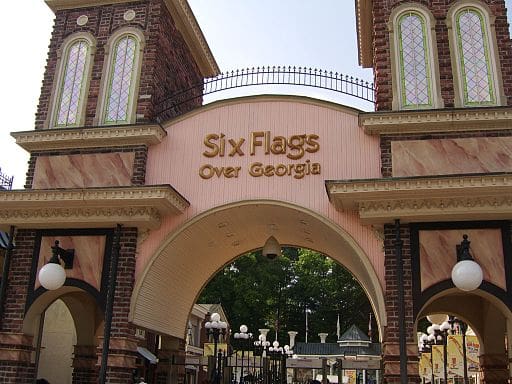Before Six Flags Over Georgia opened, the surrounding area of south Cobb County was rural. One of the industries common in rural life in the northern half of Georgia, even as late as the 1960s, was the production of illegal moonshine whiskey. On April 9, 1967, an Atlanta Constitution headline announced “Pair Held in Raid on Still in Cobb.” This probably wouldn’t have gotten much attention, except the raid was on property next to the soon-to-be-opened Six Flags Over Georgia amusement park.
Six Flags Over Georgia was the project of Angus Wynne, a Texas developer who founded the popular and profitable Six Flags Over Texas near Arlington. According to Six Flags Over Georgia (Images of America) by Tim Hollis, Six Flags Over Texas was begun by Wynne to generate revenue for an unrelated project, an 8,000 acre industrial park he was developing. Wynne’s son David, quoted in the book, said “It [the industrial park] was the largest planned industrial park in the nation, but had stalled in 1960, ahead of its time.”
Wynne was probably inspired by the success of Disneyland, which opened in 1955, and had been drawing huge crowds. He purchased rides and equipment from an earlier, failed, attempt at a similar theme park in Brooklyn, N.Y., and opened Six Flags Over Texas in 1961. The park was a success, and Wynne began looking for locations for expansion. In 1965 Wynne announced the purchase of 3,000 acres, and soon thereafter started development of a 275-acre portion of the south Cobb land, which had been on the site of a large dairy farm.
On Feb. 13, 1966, the Atlanta Constitution ran a short announcement entitled “Talent Scouts Seek Students for Revue”. Auditions were to be held at the University of Georgia and Georgia Tech. The announcement described the auditions as scouting for their Campus Revue at Six Flags Over Texas, but the company was laying the groundwork for its Georgia facility.
In another article on July 13, the Constitution reported on the progress of the theme park, and mentioned a controversy over the name. Georgia had not experienced the flags of six distinct governments flying over it. At a press luncheon at the site of the park, Wynne brushed aside the flag discussion, saying that the name was chosen mostly to connect it directly with the Texas theme park, which was already widely known. He said that when the park opened, planned for June 1, 1967 (the opening was later delayed until June 16), it would be staffed by 1,500 students, including the advanced guard who had been chosen during the local university revue auditions. Those students were already working at the Texas theme park at the time of Wynne’s statement.
Six Flags continued auditioning students to work at the facility through 1966 and early 1967, while the rides were installed and the park readied for visitors. By May, 1967, one month before the opening, the park still needed another 1,000 students before opening day.
The park opened June 16, with features such as the Sid and Marty Krofft puppet show, the Music Hall revue, a petting zoo for the children, and, of course, rides like the “Log Jamboree”, the “Dahlonega Mine” the “Flying Saucer” and the roller coaster. It has gone through many changes in its attractions over the decades, and has been a major part of south Cobb’s economy, shown by the many roads in the area that include the name “Six Flags”.
This June will mark the 50th anniversary of Six Flags, proving that Wynne’s idea for a theme park here was a resounding success.
